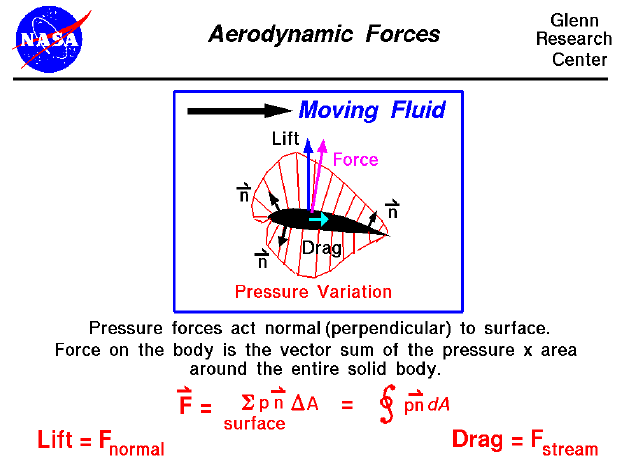Date: Sat Jul 1 04:01:29 2000
Posted By: Paolo Omodei-Zorini, Secondary School Teacher, Aerospace dept., OZP Aerospace R&D
Area of science: Engineering
ID: 957362594.Eg
Message:
Paolo Omodei-Zorini, OZP Aerospace R&D
Dear Todd,
I don't know exactly who is building that kind of ship, so I can only
write about its general principles. When a "well shaped" surface (the airfoil)
interacts with an airflow, the resulting effect is an aerodynamic force. If you
are sailing with a boat with a “tail” wind component, wind interacts with the
fabric of the sail, creating a force called “Drag”. This force, that lays
windward, is the principal component of the aerodynamic force created by the
ail. If you decide to sail with an airfoil, as you have written, it will
generate “Lift”. This force, that is the other component of the aerodynamic
force (in a 2 dimensional view), is perpendicular to drag (90° from the
direction of the airflow, called relative wind in aerodynamics), is greater than
drag in a typical plane’s wing profile and can be used as “pulling” force in
a “sea” application instead of drag.
So both airfoils and sails use the aerodynamic force, that can be divided into
Drag and lift. I have taken this image from the Nasa website I have written the
address below.
 Lift increases proportionally with the angle between the relative wind and
the chord of the airfoil (the chord is the line from the “nose” to the “tail” of
the airfoil, called “leading edge” and “trailing edge”): this angle is called
“angle of attack”. The increasing of lift is limited to a value (generally 15 –
18 degrees for wing’s profiles) of “angle of attack”: if the limit is passed,
lift will rapidly decrease because the airflow around the airfoil is unstable
and will not cover in the right manner the shape of the airfoil: this situation
is called “stall”. (In the real world, the angle between the relative wind and
a straight sail will generate some lift too, but it’s not our topic now...)
So if you decide to use lift generated from an airfoil shaped sail, your boat
will be limited in some parameters :
Lift increases proportionally with the angle between the relative wind and
the chord of the airfoil (the chord is the line from the “nose” to the “tail” of
the airfoil, called “leading edge” and “trailing edge”): this angle is called
“angle of attack”. The increasing of lift is limited to a value (generally 15 –
18 degrees for wing’s profiles) of “angle of attack”: if the limit is passed,
lift will rapidly decrease because the airflow around the airfoil is unstable
and will not cover in the right manner the shape of the airfoil: this situation
is called “stall”. (In the real world, the angle between the relative wind and
a straight sail will generate some lift too, but it’s not our topic now...)
So if you decide to use lift generated from an airfoil shaped sail, your boat
will be limited in some parameters :
- Due to the weight and to the drag of a boat, it work well only
with strong winds (30 mph or more, I suppose)
- Lift, as I have written before, is perpendicular to the relative
wind, so you can only sail with crosswind.
- Limitations about angle of attack will create problems with the
range of wind directions you can use to sail
Of course, I hope this prototype will be successful ;o)
I hope to have been useful, and I will happy to answer other questions if this
is not the one you were looking for.
Paolo Omodei-Zorini
More information on the topics of aerodynamics can be found at this url:
http://www.gr
c.nasa.gov/Other_Groups/K-12/airplane/bga.html
Current Queue |
Current Queue for Engineering |
Engineering archives
Try the links in the MadSci Library for more information on Engineering.
MadSci Home | Information |
Search |
Random Knowledge Generator |
MadSci Archives |
Mad Library | MAD Labs |
MAD FAQs |
Ask a ? |
Join Us! |
Help Support MadSci
MadSci Network,
webadmin@www.madsci.org
© 1995-2000. All rights reserved.

